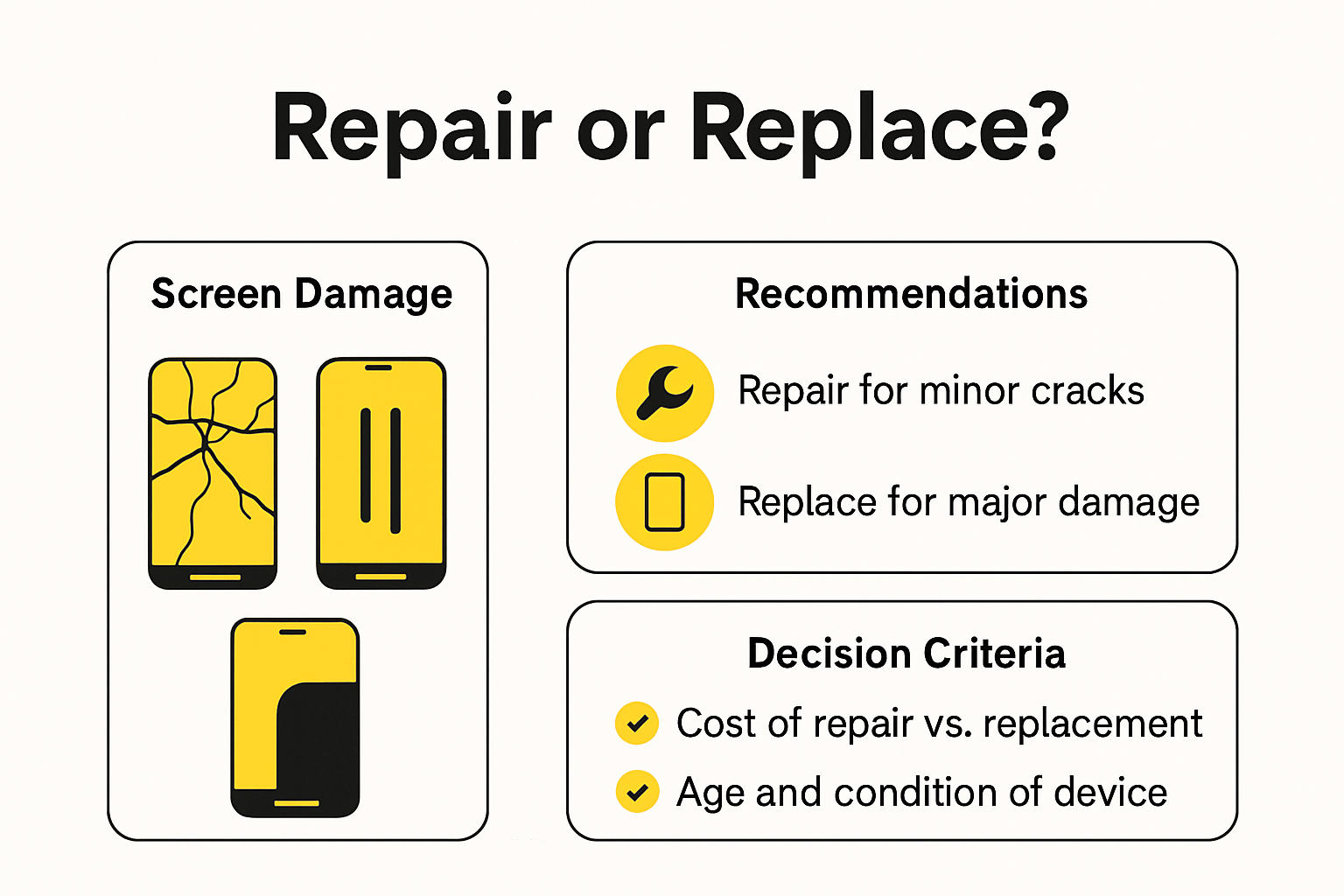
Screen damage is a headache nearly every South African tech pro or business faces, with replacement parts sometimes costing anywhere from R6,000 to R17,000 depending on where you source them. Sounds outrageous, right? Oddly enough, paying top dollar for a new screen is not always the smart move. Choosing repair over replacement can actually save you serious cash and keep your devices running at peak performance.
Table of Contents
- Understanding Screen Damage: When To Repair Or Replace
- Screen Repair Vs Replacement: Costs And Benefits
- Special Needs For Professionals And Tech Buyers
- Choosing Trusted Service Providers In South Africa And Beyond
Quick Summary
| Takeaway | Explanation |
|---|---|
| Assess Screen Damage Type | Understanding the severity of screen damage, whether superficial scratches or cracked screens, is crucial in determining whether repair or replacement is necessary. Professionals should evaluate structural integrity and potential spread of damage before making decisions. |
| Balance Costs and Performance | The decision to repair or replace should consider both direct repair costs and indirect costs such as device downtime. Establishing a total repair cost limit can help determine when replacement becomes more viable financially. |
| Implement Preventive Strategies | Investing in high-quality protective screens and maintaining regular inspection protocols can significantly reduce the likelihood of future screen damage, leading to lower repair costs and improved device reliability. |
| Choose Reliable Service Providers | When selecting screen repair services, professionals should verify credentials, technical expertise, and industry standards to ensure high-quality repairs that preserve device functionality and warranty. |
| Develop Strategic Repair Frameworks | Professionals should create robust decision matrices for assessing screen damage, taking into account warranty implications, performance requirements, and compliance with industry standards to optimize device lifecycle management. |
Understanding Screen Damage: When to Repair or Replace
Screen damage represents a critical decision point for tech professionals and device owners, where the balance between repair and replacement determines both financial investment and device functionality. Understanding the nuanced factors that influence this choice requires a strategic approach that goes beyond surface-level assessment.
Types of Screen Damage and Their Implications
Screen damage manifests in multiple complex forms, each presenting unique challenges for resolution. Superficial scratches might seem minor but can progressively worsen, potentially compromising device integrity. According to a South African Journal of Industrial Engineering study, strategic decision-making in component renewal involves analyzing expected value and long-term performance implications.
Cracked screens represent a more severe scenario. Hairline fractures can quickly spread, transforming a minor issue into a complete screen failure. Professionals must assess several critical factors:
- Structural Integrity: Evaluate whether the crack compromises touch sensitivity or internal electronic connections
- Spread Potential: Determine the likelihood of damage expanding under regular usage conditions
- Repair Cost: Compare professional repair expenses against potential replacement investment

Economic and Technical Considerations for Screen Repair
The decision between repair and replacement transcends simple cost calculations. Research from South African technology assessment frameworks suggests a comprehensive approach that considers device age, technological obsolescence, and repair complexity.
Professional technicians typically evaluate screen damage through multiple diagnostic lenses:
- Screen replacement cost relative to device value
- Warranty implications of third-party repairs
- Performance degradation potential after repair
- Technical complexity of screen restoration
For industrial and professional users, screen damage represents more than a cosmetic issue. A compromised screen can interrupt critical workflows, impact data visibility, and potentially compromise safety in high-stakes environments like construction, marine operations, or healthcare settings.

Professional Strategies for Screen Management
Preventive strategies often prove more cost-effective than reactive repairs. The South African Journal of Bioethics and Law emphasizes the importance of proactive device integrity assessment, which translates directly to screen maintenance.
Key recommendations for professionals include:
- Investing in high-quality protective screens
- Regular device inspection protocols
- Establishing clear repair vs replacement thresholds
- Maintaining comprehensive device maintenance records
Ultimately, the screen repair versus replacement decision requires a nuanced understanding of technical, economic, and operational factors. Professionals must balance immediate cost considerations with long-term device performance and reliability.
By adopting a strategic approach that considers technological, financial, and operational dimensions, tech buyers and professionals can make informed decisions that optimize device longevity and operational efficiency.
To help compare the main factors influencing screen repair versus replacement, refer to the table below:
| Factor | Screen Repair | Screen Replacement |
|---|---|---|
| Cost | Lower upfront (R6,000+) | Higher (can reach R17,000) |
| Downtime | Usually shorter | Can be longer |
| Warranty Impact | May void if not authorised | Maintains warranty if official |
| Device Age Relevance | Cost-effective on newer | Better for very old devices |
| Risk of Performance Degradation | Possible if repair is poor | Low if original parts |
| Long-term Reliability | Depends on repair quality | High with new screen |
Screen Repair vs Replacement: Costs and Benefits
Navigating the complex landscape of screen damage repair requires a strategic financial analysis that goes beyond simple cost comparisons. Professionals and tech enthusiasts must consider multiple dimensions when deciding between repair and replacement strategies.
Financial Evaluation of Repair and Replacement
Cost analysis represents the primary consideration in screen damage resolution. A University of the Witwatersrand study demonstrated the critical importance of establishing a total repair cost (TRC) limit policy. This approach helps professionals determine the precise point where replacement becomes more economically viable than repair.
Key financial factors include:
- Direct Repair Costs: Labor and parts replacement expenses
- Indirect Costs: Potential device downtime and productivity loss
- Long-term Performance: Expected functionality after repair
- Residual Device Value: Impact on overall device market worth
The Kinsey Report revealed significant price variations in replacement parts, highlighting that sourcing can dramatically influence total repair expenses. For instance, identical replacement components might range from R6,000 to R17,000 depending on international sourcing strategies.
Below is a summary table showing the cost range for screen replacement parts and key influencing factors:
| Cost Factor | Description | Example Range |
|---|---|---|
| Replacement Part Cost | Varies by device/model and sourcing method | R6,000 - R17,000 |
| Labour | Professional service fees | Included/Extra |
| Sourcing Strategy | Local vs international supply | Can affect price |
| Device Downtime | Productivity loss due to repairs/replacement | Indirect cost |
| Warranty Impact | Third-party repair may void warranty | Risk varies |
Technical Considerations in Screen Restoration
Beyond financial metrics, technical complexity plays a crucial role in repair decision-making. The South African Motor Body Repairers’ Association emphasizes that technological advancements have significantly improved repair capabilities across various device categories.
Professionals must evaluate:
- Extent of existing screen damage
- Device model and technological specifications
- Availability of genuine replacement components
- Potential performance degradation post-repair
Critical technical assessment involves understanding whether repair will fully restore device functionality or merely provide a temporary solution. Some screen damages compromise internal electronic connections, making complete replacement the most reliable option.
Strategic Decision-Making Framework
Developing a systematic approach to screen repair versus replacement requires comprehensive evaluation. Professionals should create a decision matrix considering:
- Current device age
- Warranty implications
- Performance requirements
- Budget constraints
- Future technological needs
For industrial users working with specialized equipment like thermal imaging devices or rugged smartphones, the decision becomes even more nuanced. A seemingly minor screen repair could potentially compromise critical operational capabilities.
Ultimately, the screen repair versus replacement decision demands a holistic approach. By integrating financial analysis, technical assessment, and strategic foresight, professionals can make informed choices that balance immediate cost considerations with long-term device performance and reliability.
Tech buyers must view screen damage not as an isolated issue but as an opportunity to optimize device lifecycle management, ensuring maximum operational efficiency and technological investment protection.
Special Needs for Professionals and Tech Buyers
Professionals and tech buyers operate in dynamic environments where device performance isn’t just a luxury but a critical operational requirement. Screen damage and repair strategies demand specialized considerations that go far beyond typical consumer approaches.
Industry-Specific Screen Damage Challenges
Different professional sectors experience unique screen damage scenarios that require tailored resolution strategies. Construction, marine operations, healthcare, and security professionals face environmental challenges that dramatically impact device durability and screen integrity.
Rugged Device Considerations:
- Industrial Environments: Extreme temperatures, dust, and vibration create unique screen stress conditions
- Field Operations: Outdoor workers require devices capable of withstanding harsh environmental impacts
- Precision Equipment: Technical professionals need screens that maintain calibration and visual accuracy
The South African Motor Body Repairers’ Association emphasizes the importance of understanding repair guidelines specific to professional equipment, noting that repair strategies must align with industry-specific performance standards.
Technical Performance and Reliability Metrics
Professionals cannot compromise on device functionality. Screen repairs must guarantee:
- Full touch sensitivity restoration
- Original display color and brightness
- No internal electronic connection disruption
- Maintaining original device water and dust resistance
SAWRA guidelines highlight that damage assessment requires microscopic precision. For specialized equipment like thermal imaging devices or medical diagnostic tools, even minimal screen imperfections can compromise critical operational capabilities.
Strategic Repair Decision Framework for Professionals
Developing a comprehensive screen repair strategy involves multiple strategic considerations:
- Warranty preservation
- Compliance with industry technical standards
- Minimal operational disruption
- Cost-effectiveness relative to device replacement
- Maintaining data integrity and device security
For professionals in high-stakes environments like healthcare, marine operations, or security sectors, screen damage represents more than a cosmetic issue. A compromised screen can interrupt critical workflows, impact data visibility, and potentially compromise safety protocols.
Technical buyers must implement robust device management protocols that:
- Establish clear screen damage assessment criteria
- Create standardized repair vs replacement decision matrices
- Develop relationships with certified repair technicians
- Maintain comprehensive device maintenance records
Ultimately, screen repair for professionals transcends simple cost calculations. It represents a strategic decision that directly impacts operational efficiency, workplace safety, and technological investment protection.
By adopting a holistic approach that integrates technical performance, financial considerations, and industry-specific requirements, professionals can optimize their device lifecycle management and ensure maximum technological reliability.
Choosing Trusted Service Providers in South Africa and Beyond
Selecting a reliable screen repair service represents a critical decision for professionals and tech enthusiasts, requiring meticulous evaluation of technical expertise, reputation, and industry credentials.
Credential Verification and Professional Standards
The South African Motor Body Repairers’ Association emphasizes that consumers possess the fundamental right to choose service providers who meet stringent professional standards. Professionals must conduct comprehensive background checks that extend beyond surface-level marketing claims.
Critical credential assessment criteria include:
- Industry Certifications: Verified technical training credentials
- Manufacturer Accreditations: Official recognition from device manufacturers
- Professional Memberships: Active participation in recognized technical associations
- Quality Management Systems: Documented process standards and quality control protocols
Key verification steps involve:
- Requesting detailed professional credentials
- Checking independent customer reviews
- Validating warranty preservation policies
- Examining technical repair documentation processes
Technical Expertise and Specialized Capabilities
The South African Windscreen Repair Association highlights that technical expertise goes beyond basic repair skills. Professionals require specialized knowledge across multiple device categories and technological platforms.
Advanced service providers demonstrate capabilities through:
- Comprehensive diagnostic equipment
- Sophisticated screen restoration technologies
- Precise calibration tools
- Advanced electronic connection testing mechanisms
Professional users must evaluate service providers based on their ability to handle complex screen repairs across diverse device categories, including:
- Rugged industrial smartphones
- Specialized thermal imaging devices
- Medical diagnostic equipment
- High-end consumer electronics
Risk Mitigation and Long-term Service Quality
Choosing a service provider involves strategic risk assessment that considers multiple performance dimensions. Professionals should develop a holistic evaluation framework that encompasses:
- Warranty preservation capabilities
- Technical repair success rates
- Post-repair device performance guarantees
- Transparent pricing structures
- Rapid turnaround times
- Comprehensive technical support
Key recommendation strategies include:
- Requesting detailed repair portfolios
- Conducting reference checks with previous corporate clients
- Verifying insurance and liability coverage
- Understanding comprehensive repair documentation processes
For tech buyers operating in high-stakes professional environments, screen repair represents more than a technical transaction. It is a critical investment in operational continuity and technological reliability.
By implementing a rigorous selection process that prioritizes technical competence, professional credentials, and comprehensive service quality, professionals can mitigate risks and ensure optimal device performance across diverse technological ecosystems.
Frequently Asked Questions
What factors should I consider when deciding between screen repair and replacement?
When deciding between screen repair and replacement, consider the type and severity of the damage, repair costs versus replacement costs, the age of your device, and the potential impact on performance and warranty.
How much does screen replacement typically cost in South Africa?
Screen replacement costs in South Africa can range from R6,000 to R17,000, depending on the device model and where you source the replacement parts.
Can screen repairs affect my device’s warranty?
Yes, screen repairs performed by unauthorized service providers may void your device’s warranty. It’s important to check warranty implications before proceeding with repairs.
What preventive measures can I take to avoid screen damage?
To avoid screen damage, invest in high-quality protective screens, conduct regular inspections of your devices, and establish clear repair versus replacement thresholds to manage risks effectively.
Maximise Your Device Investment with Premium Tech Solutions
Are you tired of facing the same tough decision every time your device screen gets cracked or scratched? The article breaks down how costly and risky it can be to choose between repairing a screen and replacing it. Many pros and tech buyers feel frustrated when expensive repairs disrupt both their budget and their workflow. If you are in construction, marine operations, security, or simply demand more from your tech, then you know how vital reliable screens and durable devices are for long-term performance.

Now is the time to upgrade your approach and protect your bottom line. At PMC Jewellery, you get rugged smartphones, premium tablets, and professional gear designed to minimise costly downtime. Explore advanced options like Ulefone Armor, DOOGEE, or our high-end Xiaomi and OnePlus range. Each product is built for professionals who value resilience and technical excellence, and all come with the right accessories such as cases and screen protection that align with the article’s advice on preventive strategies. If you want to keep your devices functional and avoid repeat repair costs, visit PMC Jewellery to see how our specialised technology can help you make smarter choices today. You can also browse our selection of phone accessories to maximise protection and value for every device you own.
Recommended
- For Samsung Galaxy Watch 5 44mm 20mm Two-color Stripe Silicone Watch B – PMC Jewellery
- FNGEEN 4006 Men Trendy Waterproof Quartz Watch(Black Leather Black Ste – PMC Jewellery
- 8-shape Buckle Retro Leather Watch Band For Apple Watch Series 9&8&7 4 – PMC Jewellery
- Small Waist 8-shape Reverse Buckle Leather Watch Band For Apple Watch – PMC Jewellery
- For Samsung Galaxy Watch 5 40mm 20mm Two-color Stripe Silicone Watch B – PMC Jewellery
- For Samsung Galaxy Watch 3 41mm 20mm Carbon Fiber Striped Silicone Wat – PMC Jewellery
